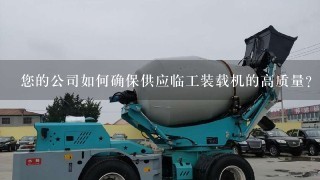您的公司如何确保供应临工装载机的高质量?

Answer:
Ensuring High Quality of Supply Chain Components
1. Supplier Selection and Qualification:
- Conduct thorough background checks and supplier audits to verify their capabilities, certifications, and financial stability.
- Seek references and testimonials from previous clients.
- Establish clear supplier selection criteria based on quality, reliability, and responsiveness.
2. Supplier Quality Management System:
- Implement a robust supplier quality management system that outlines quality requirements, inspection procedures, and non-conformance management.
- Conduct regular audits and inspections to ensure compliance.
- Establish a dedicated team responsible for supplier quality management.
3. Supplier Performance Monitoring:
- Track key performance indicators (KPIs) such as delivery times, quality control results, and customer satisfaction ratings.
- Conduct regular performance reviews to identify areas for improvement.
- Implement corrective actions and implement continuous improvement initiatives.
4. Supplier Risk Management:
- Identify and assess potential risks associated with supply chain components, such as supplier dependence, geopolitical factors, and supply chain disruptions.
- Develop mitigation strategies to minimize these risks.
5. Supplier Compliance and Certification:
- Ensure that all suppliers comply with relevant industry standards, certifications (e.g., ISO 9001, ISO 14001), and safety regulations.
- Verify that suppliers have the necessary certifications for the components they produce.
6. Supplier Collaboration and Communication:
- Establish open and transparent communication channels with suppliers.
- Provide clear and concise specifications and requirements.
- Foster collaboration and share information to improve supply chain efficiency and quality.
7. Continuous Improvement:
- Regularly review and update supply chain processes and practices to ensure alignment with changing market conditions and customer expectations.
- Implement lean and Six Sigma principles to optimize operations and reduce waste.
8. Supplier Relationship Management:
- Build strong relationships with suppliers through regular communication, feedback, and collaboration.
- Foster a culture of continuous improvement and shared success.
By implementing these measures, companies can ensure the high quality of their supply chain components, reducing the risk of delays, defects, and customer dissatisfaction.





































































